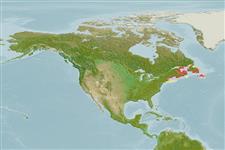Environment: milieu / climate zone / depth range / distribution range
Ekologi
marina; brackvatten bentopelagisk. Temperate; 52°N - 41°N
Western Atlantic: Newfoundland, Canada to Massachusetts, USA.
Size / Vikt / Age
Maturity: Lm ? range ? - ? cm
Max length : 7.6 cm TL hane/ej könsbestämd; (Ref. 5951); common length : 3.5 cm TL hane/ej könsbestämd; (Ref. 12193); rapporterad maxålder: 1.00 år (Ref. 12193)
Adults occur near shore in beds of vegetation, often around floating vegetation a short distance from shore. Rarely enter fresh water (Ref. 7251). Males build, guard and aerate the nest where the eggs are deposited (Ref. 205).
Life cycle and mating behavior
Könsmognad | Reproduktion | Lek | Ägg | Fecundity | Larver
Males build, guard and aerate the nest where the eggs are deposited (Ref. 205).
Robins, C.R. and G.C. Ray, 1986. A field guide to Atlantic coast fishes of North America. Houghton Mifflin Company, Boston, U.S.A. 354 p. (Ref. 7251)
IUCN Red List Status (Ref. 130435)
Threat to humans
Harmless
Human uses
Ytterligare information
referenserVattenbrukVattenbruksprofilAvelslinjerGenetikElectrophoresesÄrftlighetSjukdomarBehandlingNutrientsMass conversion
MedarbetareBilderStamps, Coins Misc.LjudCiguateraHastighetSimsättGälytaOtolithsHjärnstorlekSyn
Verktyg
Special reports
Download XML
Internet-källor
Estimates based on models
Preferred temperature (Ref.
123201): 4.3 - 9, mean 6.2 °C (based on 188 cells).
Phylogenetic diversity index (Ref.
82804): PD
50 = 0.5156 [Uniqueness, from 0.5 = low to 2.0 = high].
Bayesian length-weight: a=0.01047 (0.00408 - 0.02689), b=3.07 (2.85 - 3.29), in cm total length, based on LWR estimates for this (Sub)family-body shape (Ref.
93245).
Trofisk nivå (Ref.
69278): 3.3 ±0.1 se; based on diet studies.
Resiliens (Ref.
120179): Hög, lägsta populationsfördubblingstid mindre än 15 månader (tmax=1).
Fishing Vulnerability (Ref.
59153): Low vulnerability (10 of 100).
